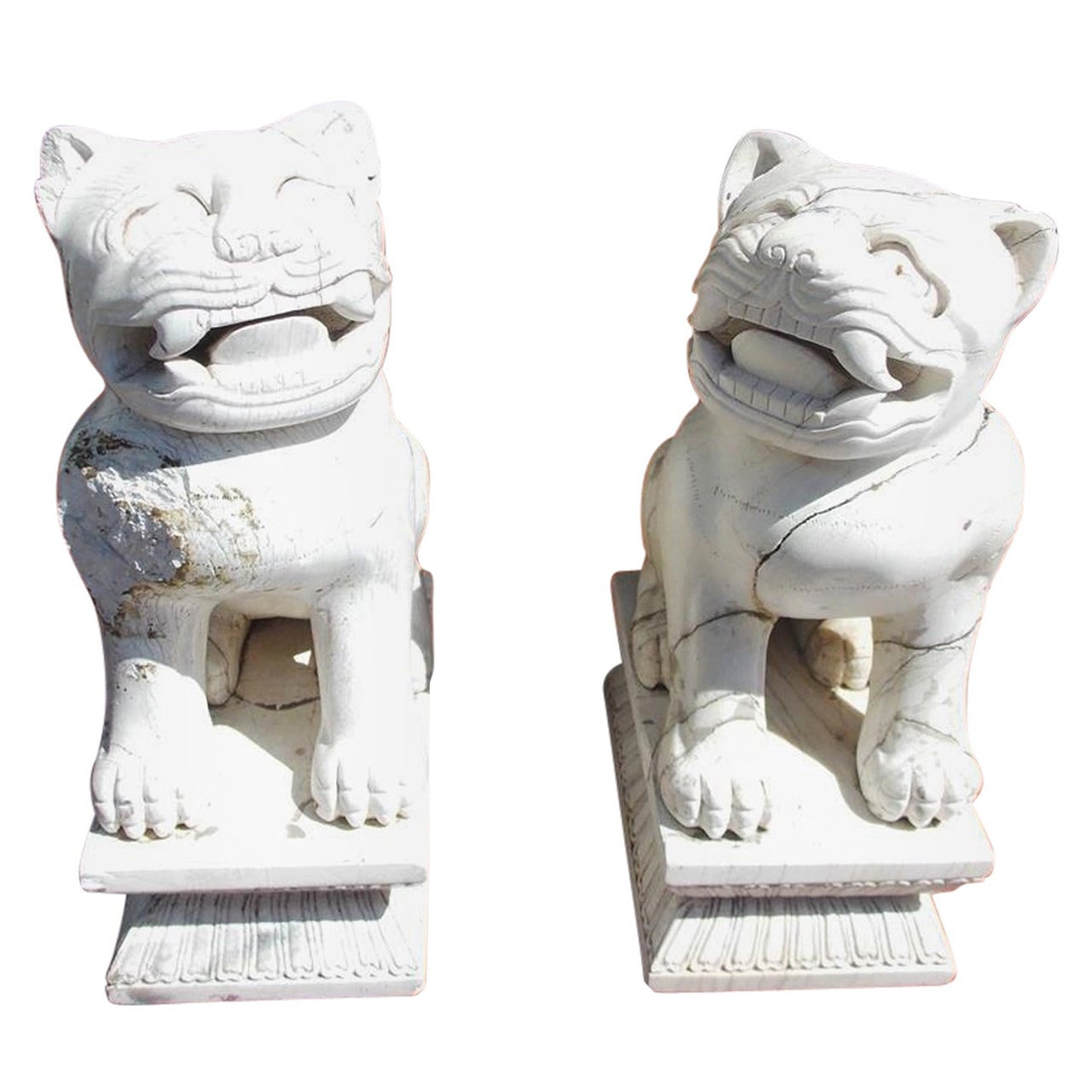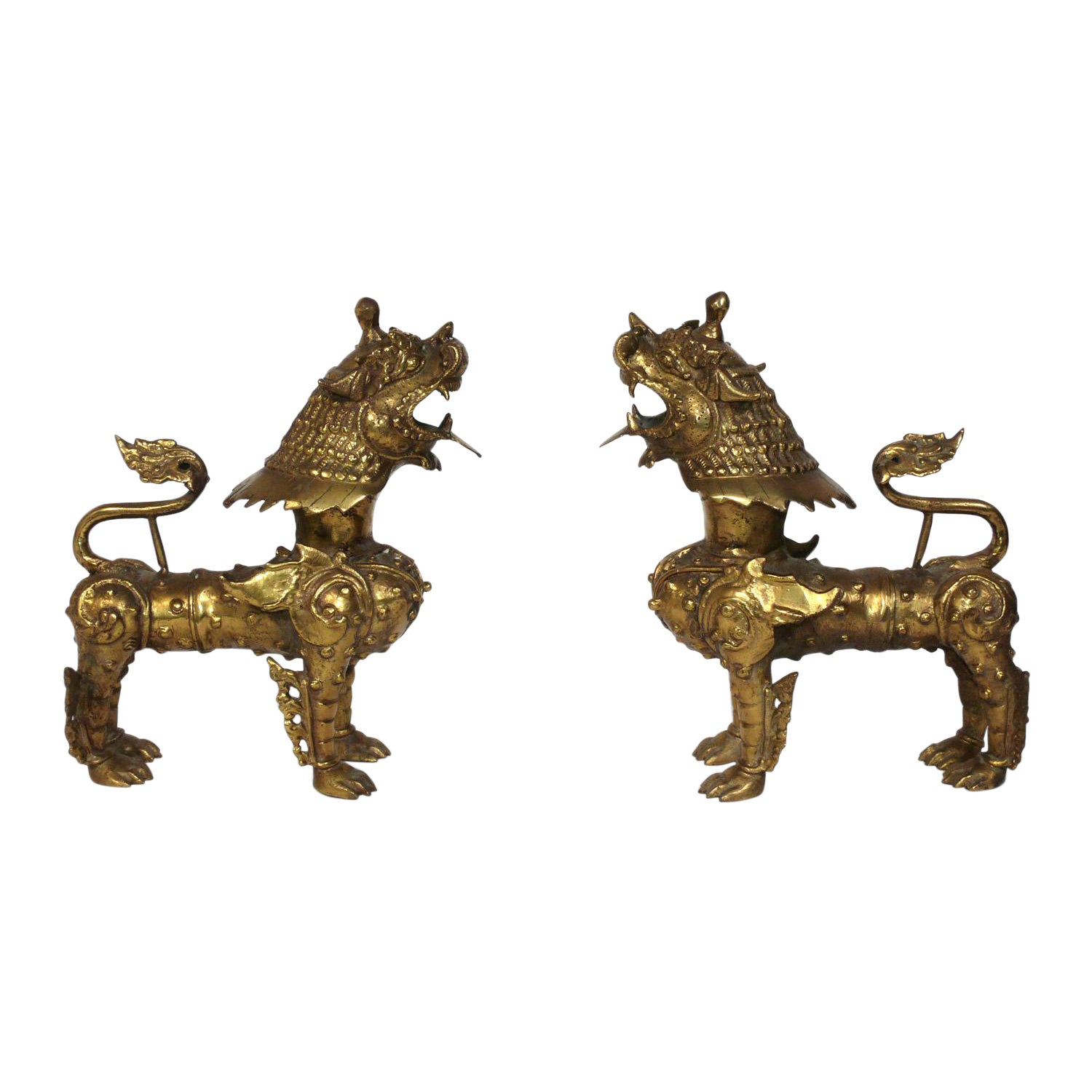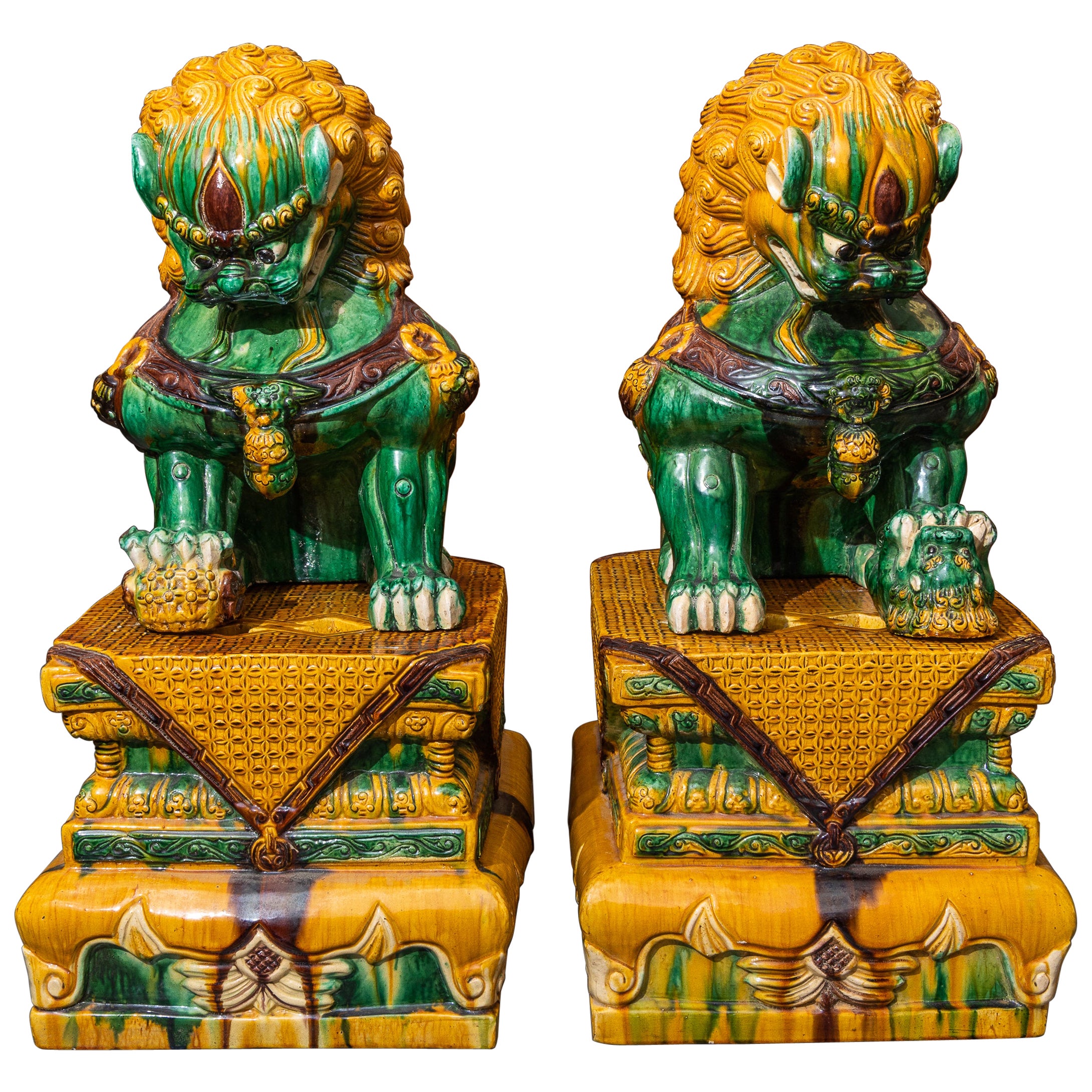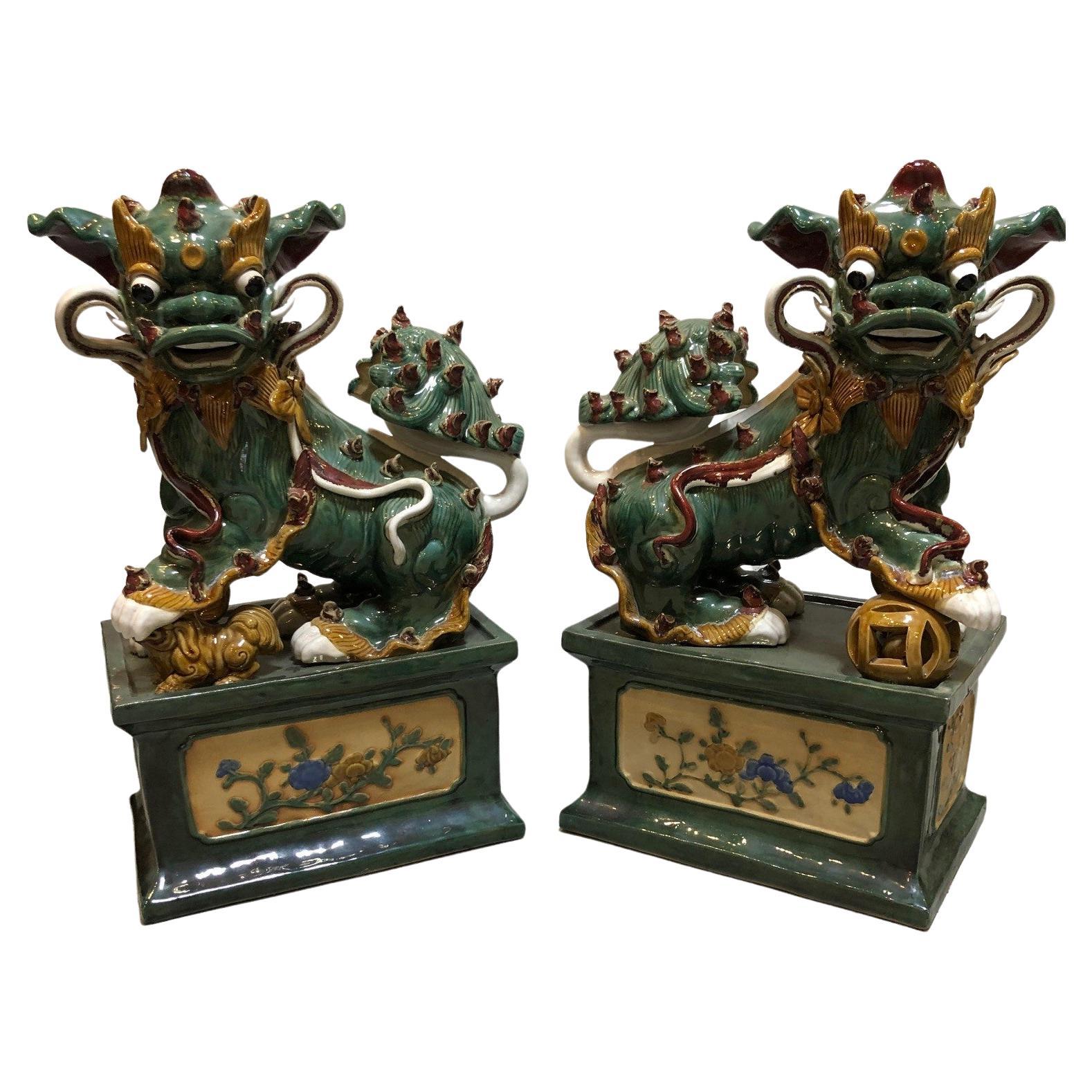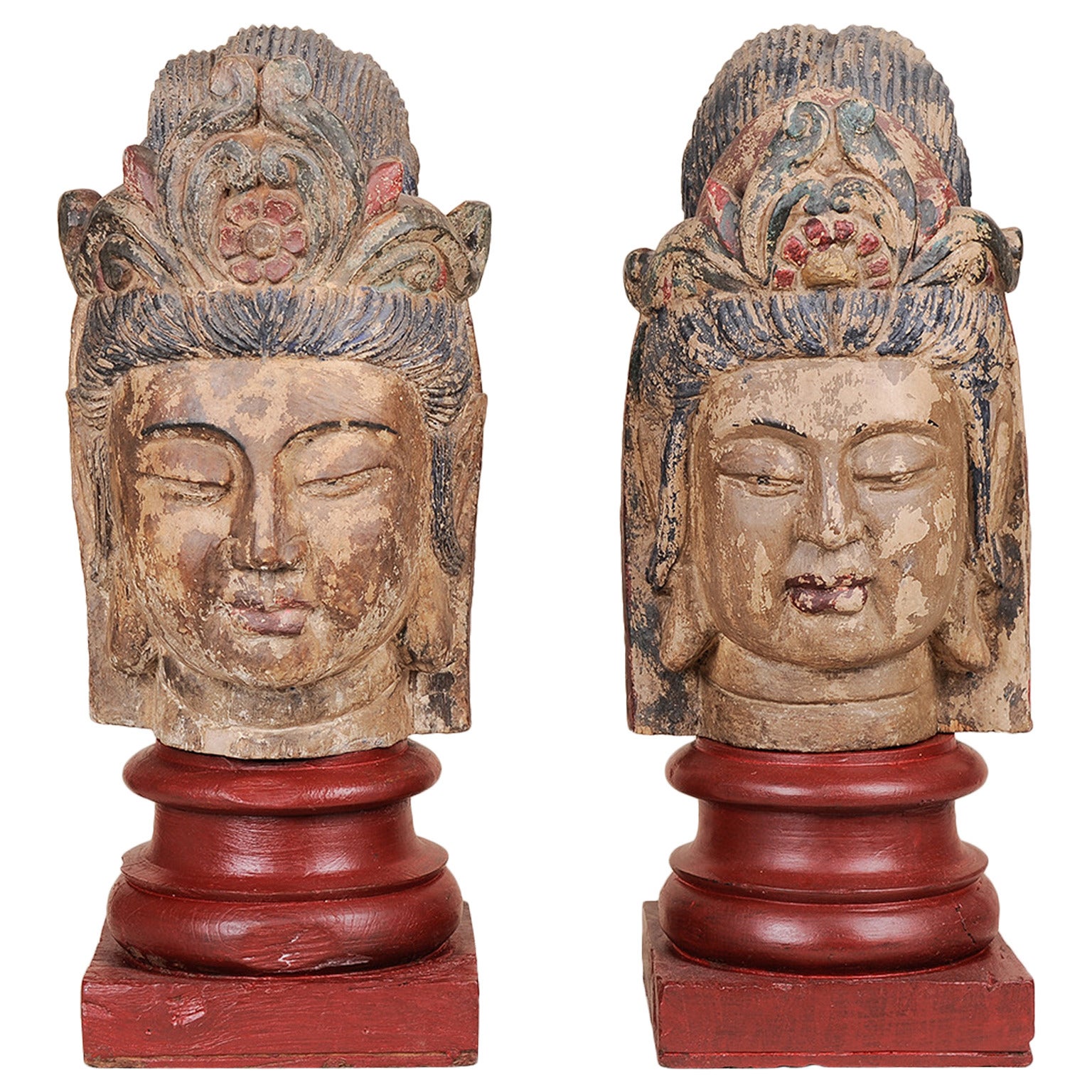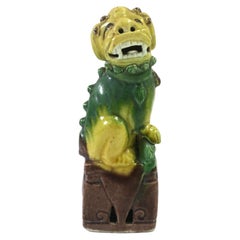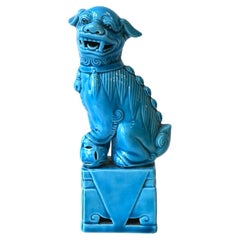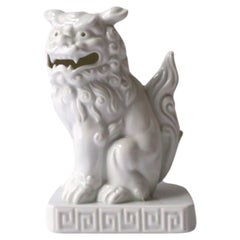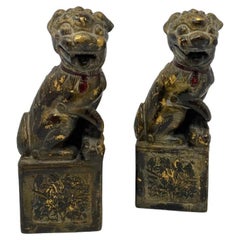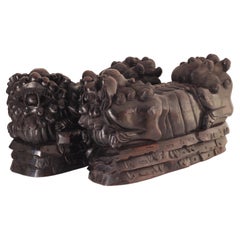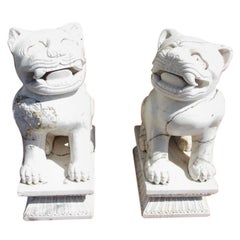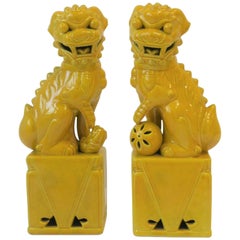
Pair of Tall Midcentury Yellow Foo Dogs or Lion Sculptures
View Similar Items
Want more images or videos?
Request additional images or videos from the seller
1 of 17
Pair of Tall Midcentury Yellow Foo Dogs or Lion Sculptures
About the Item
- Dimensions:Height: 14 in (35.56 cm)Width: 5.5 in (13.97 cm)Depth: 3.75 in (9.53 cm)
- Sold As:Set of 2
- Style:Chinoiserie (In the Style Of)
- Materials and Techniques:Ceramic,Glazed
- Place of Origin:
- Period:
- Date of Manufacture:circa 20th Century
- Condition:Wear consistent with age and use. - No chips noted.
- Seller Location:New York, NY
- Reference Number:1stDibs: LU1314210838151
About the Seller
5.0
Platinum Seller
These expertly vetted sellers are 1stDibs' most experienced sellers and are rated highest by our customers.
Established in 2010
1stDibs seller since 2015
1,868 sales on 1stDibs
More From This SellerView All
- Foo Lion Dog Green and Yellow Ceramic, circa 1930sLocated in New York, NYA single ceramic Lion Foo dog decorative object, circa early-20th century, 1930s, China. This Lion Foo Dog is green and yellow with dark brown accents and base. Piece and makes a great decorative object for a desk, shelf, library, cocktail table, etc. Dimensions: 5.75" Height. For agate dish...Category
Early 20th Century Chinese Chinoiserie Ceramics
MaterialsCeramic
- Turquoise Blue Foo Lion Dog Decorative Object, circa 1960sLocated in New York, NYA single Lion Foo dog ceramic decorative object, circa mid-20th century, 1960s, China. This Lion Foo Dog is a beautiful turquoise blue and makes a great statement piece / decorative ...Category
Mid-20th Century Chinese Chinoiserie Animal Sculptures
MaterialsCeramic
- White Porcelain Foo Dog Lion Decorative Object or Bookend from JapanLocated in New York, NYA beautiful white porcelain foo dog lion decorative object or bookend, circa early to mid-20th century, Japan. Foo dog lions, also known as komainu in Japan, are a symbol of good luc...Category
Mid-20th Century Japanese Chinoiserie Bookends
MaterialsPorcelain
- Brass Gazelle Antelope Sculpture Decorative Object, TallBy Karl SpringerLocated in New York, NYA brass animal Gazelle antelope bust sculpture decorative object with tall antlers, circa late-20th century, 1970s. Dimensions: 21.5" Height.Category
Vintage 1970s Modern Animal Sculptures
MaterialsBrass
- Tiger or Lion Cat Paw Decorative Object or Bookend the Empire StyleLocated in New York, NYA substantial tiger or lion cat animal paw decorative object sculpture or bookend, in the Empire design style, circa late-20th century. A great decorative object for a shelf, mantel,...Category
Late 20th Century Empire Animal Sculptures
MaterialsComposition
- Midcentury Modern Brass Sculpture, circa 1960sBy Curtis Jeré, Paul EvansLocated in New York, NYA beautiful hand-made brass sculpture, Midcentury Modern period, circa mid-20th century, 1960s. Piece is unsigned; In the style of designers Paul Evens, Curtis Jere. Piece is all brass with a square black composite base. Very good condition as shown in images. Dimensions: 22.75" Height. Other items shown available separately, search 1stDibs ref. #: Mackenzie-Childs vase, search ref. #: LU1314226933622 Agate dish...Category
Mid-20th Century Mid-Century Modern Abstract Sculptures
MaterialsComposition, Brass
$2,888 Sale Price24% Off
You May Also Like
- Vintage 1970s Neiman Marcus Japan Bronze Foo DogsBy Neiman MarcusLocated in San Diego, CAIncredibly beautiful pair of 1970s vintage bronze foo dogs by Neiman Marcus Japan. Guardian lions, also known as komainu, shishi, or foo dogs, are intimidating, mythical, lion-like c...Category
Vintage 1970s Japanese Chinoiserie Figurative Sculptures
MaterialsBronze
- A pair of 19th Century carved Foo temple dogs or Chinese guardian LionsLocated in London, GBChinese guardian lions, or imperial guardian lions, are a traditional Chinese architectural ornament. Typically made of stone, they are also known as stone lions or shishi (石獅; shíshī). They are known in colloquial English as lion dogs or foo dogs / fu dogs. The concept, which originated and became popular in Chinese Buddhism, features a pair of highly stylized lions—often one male with a ball and one female with a cub—which were thought to protect the building from harmful spiritual influences and harmful people that might be a threat. Used in imperial Chinese palaces and tombs, the lions subsequently spread to other parts of Asia including Japan (see komainu), Korea, Philippines, Tibet, Thailand, Myanmar, Vietnam, Sri Lanka, Nepal, Cambodia, Laos, and Malaysia. There has been extensive interaction between Chinese mythology and Confucianism, Taoism, and Buddhism. Elements of pre-Han dynasty mythology such as those in Classic of Mountains and Seas were adapted into these belief systems as they developed (in the case of Taoism), or were assimilated into Chinese culture (in the case of Buddhism). Elements from the teachings and beliefs of these systems became incorporated into Chinese mythology. For example, the Taoist belief of a spiritual Paradise became incorporated into mythology as the place where immortals and deities used to dwell. Sometimes mythological and religious ideas have become widespread across China's many regions and diverse ethnic societies. In other cases, beliefs are more limited to certain social groups, for example, the veneration of white stones by the Qiang. One mythological theme that has a long history and many variations involves a shamanic world view, for example in the cases of Mongolian shamanism among the Mongols, Hmong shamanism among the Miao people, and the shamanic beliefs of the Qing dynasty from 1643 to 1912, derived from the Manchus. Politically, mythology was often used to legitimize the dynasties of China, with the founding house of a dynasty claiming a divine descent. Mythology and philosophy. Further information: Chinese philosophy True mythology is distinguished from philosophical treatises and theories. Elaborations on the Wu Xing are not really part of mythology, although belief in five elements could appear. The Hundred Schools of Thought is a phrase suggesting the diversity of philosophical thought that developed during the Warring States of China. Then, and subsequently, philosophical movements had a complicated relationship with mythology. However, as far as they influence or are influenced by mythology, divides the philosophical camps into two rough halves, a Liberal group and a Conservative group. The liberal group being associated with the idea of individuality and change, for example as seen in the mythology of divination in China, such as the mythology of the dragon horse that delivered the eight bagua diagrams to Fu Xi, and methods of individual empowerment as seen in the Yi Jing (Book of Changes). The Liberal tendency is towards individual freedom, Daoism, and Nature. The relationship of the Conservative philosophies to mythology is seen in the legendary Nine Tripod Cauldrons, mythology about the emperors and central bureaucratic governance, Confucianism, written histories, ceremonial observances, subordination of the individual to the social groups of family and state, and a fixation on stability and enduring institutions. The distinction between the Liberal and Conservative is very general, but important in Chinese thought. Contradictions can be found in the details, however these are often traditional, such as the embrace by Confucius of the philosophical aspects of the Yi Jing, and the back-and-forth about the Mandate of Heaven wherein one dynasty ends and another begins based according to accounts (some of heavily mythological) where the Way of Heaven results in change, but then a new ethical stable dynasty becomes established. Examples of this include the stories of Yi Yin, Tang of Shang and Jie of Xia or the similar fantastic stories around Duke of Zhou and King Zhou of Shang. Mythology exists in relationship with other aspects of society and culture, such as ritual. Various rituals are explained by mythology. For example, the ritual burning of mortuary banknotes (Hell Money), lighting fireworks, and so on. A good example of the relationship of Chinese mythology and ritual is the Yubu, also known as the Steps or Paces of Yu. During the course of his activities in controlling the Great Flood, Yu was supposed to have so fatigued himself that he lost all the hair from his legs and developed a serious limp. Daoist practitioners sometimes incorporate a curiously choreographed pedal locomotion into various rituals. Mythology and practice, one explains the other: in these rituals, the sacred time of Yu merges with the sacral practice of the present. Various ideas about the nature of the earth, the universe, and their relationship to each other have historically existed as either a background or a focus of mythologies. One typical view is of a square earth separated from a round sky by sky pillars (mountains, trees, or undefined). Above the sky is the realm of Heaven, often viewed of as a vast area, with many inhabitants. Often the heavenly inhabitants are thought to be of an "as above so below" nature, their lives and social arrangements being parallel to those on earth, with a hierarchical government run by a supreme emperor, many palaces and lesser dwellings, a vast bureaucracy of many functions, clerks, guards, and servants. Below was a vast under ground land, also known as Diyu, Yellow Springs, Hell, and other terms. As time progressed, the idea of an underground land in which the souls of the departed were punished for their misdeeds during life became explicit, related to developments in Daoism and Buddhism. The underground world also came to be conceived of as inhabited by a vast bureaucracy, with kings, judges, torturers, conductors of souls, minor bureaucrats, recording secretaries, similar to the structure of society in the Middle Kingdom (earthly China). Chinese temple Dogs...Category
Antique 1860s Chinese Chinese Export Sculptures and Carvings
MaterialsHardwood
- Pair of Chinese Carved Stone Foo Dogs on Rectangular Plinths, 20th CenturyLocated in Hollywood, SCPair of Chinese hand carved stone Foo dogs resting on rectangular decorative carved plinths. 20th CenturyCategory
20th Century Chinese Chinese Export Animal Sculptures
MaterialsStone
- Asian Bronze Foo DogsLocated in Atlanta, GAPair of Asian Bronze Foo Dogs or Kylin Dragon, probably Tibetan, circa 1940s or earlier. They retain their warm original patina. These were purchased f...Category
Vintage 1940s Tibetan Chinoiserie Sculptures and Carvings
MaterialsBronze
$1,800 / set - Pair vintage Teal Foo Dogs Hollywood Regency ChinoiserieLocated in West Palm Beach, FLLovely pair of vintage teal green blue foo dogs. No chips or breaks.Category
Vintage 1970s Chinoiserie Ceramics
$1,920 Sale Price / set20% Off - Large Pair of Chinese Foo Dogs on PlinthsLocated in WEST PALM BEACH, FLThis is a handsome pair of vintage Chinese ceramic foo lions hand-painted in traditional green and color colors under a glaze. The figures are situated in a regal position atop an i...Category
Early 20th Century Chinese Other Ceramics
MaterialsClay
$3,400 / set


